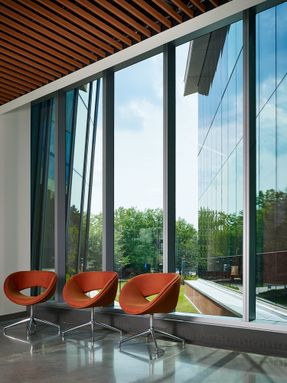
Bowie State University Center for Natural Sciences
ARCHITECTS
Perkins+Will
PLUMBING ENGINEER
WFT Engineering
EDUCATIONAL PLANNING
Sim Health
MECHANICAL ENGINEER
Mueller Associates
ELECTRICAL ENGINEER
Mueller Associates
TECHNOLOGY CONSULTANT
USSI & Convergent Technologies Design Group, Inc.
MANUFACTURERS
RPG, SageGlass, United Architectural Metals, Laerdal
CONSTRUCTION MANAGER
Clark Construction Group, LLC
CIVIL ENGINEER
Site Resources
FURNITURE, FIXTURES & EQUIPMENT
NIKA
ACOUSTICAL CONSULTANTS
Convergent Technologies Design Group, Inc.
STRUCTURAL ENGINEER
Hope Furrer Associates
PHOTOGRAPHS
Halkin+Mason, Hall+Merrick
AREA
148995 ft²
YEAR
2017
LOCATION
Bowie, United States
CATEGORY
Research Center
Text description provided by architect.
The design for Bowie State University’s New Center for Natural Sciences, Mathematics and Nursing (CNSMN) directly addresses the mission and strategic plans put forth by the University System of Maryland, the Governor’s STEM Taskforce, and Bowie State’s expressed goals to produce highly skilled graduates in the scientific, mathematical, engineering, technological, and health professional fields.
The design strategy intentionally collocates mathematics, natural sciences, and nursing into one connected community with shared facilities, resources, and programs.
The 148,995 square foot center includes multidiscipline undergraduate teaching laboratories, research laboratories, and active learning classrooms for math, engineering, nursing, biology, chemistry, physical sciences and blended disciplines.
Select biology labs are a hybrid active learning classroom and wet lab all in one, increasing utilization and functionality over the life of the building.
A greenhouse that supports both teaching and research, a “real world” nursing skills simulation suite, and other specialized core facilities, show the commitment to a fully layered education.
The state-of-the-art Nursing Education facility includes three functional suites for a realistic simulation environment. Standardized patient exam rooms and clinical skill areas include the equipment that students and professors need to support the full range of experiences for nursing education.
These simulation rooms are set up like a hospital or clinic and feature a high-tech mannequin in a hospital bed, cameras, microphones and software to capture students’ actions, and a two-way mirror so instructors can watch from a control room.
A light-filled three-story central learning and display space contribute to an overall goal to fill the building with glare-free daylight.Informal seating and work zones provide direct access to classrooms and laboratories.
The fractal-based brand expression inspires visitors, students, and faculty. Project rooms, collaboration stairs, and bridges create places for small groups of students to join together before and after class, work together on their coursework, and form relationships that will enrich their college experience.
A unique and iconic feature of the Center is the three-story, elliptical multipurpose room, which acts as a visual and functional beacon to express the University’s commitment to STEM and nursing education.
This space features dynamic glass, which tints on-demand to create a more comfortable learning environment.
This dynamic glass, which was also used in the building’s large east and west-facing curtain wall, maintains access to natural light while protecting occupants from glare and excess heat throughout the day.











